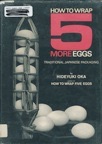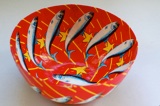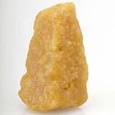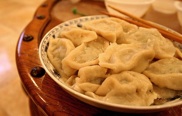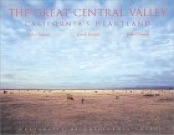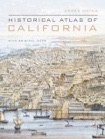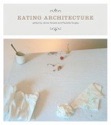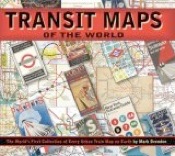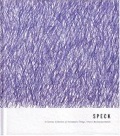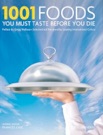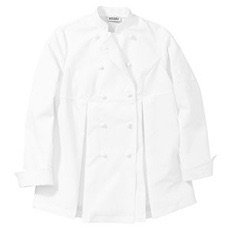Favorites
1001 Foods You Must Eat Before You Die
Although I tend to stay away from lists, the heft of this one (4 pounds 8 ounces) convinced me to give it a try. Edited by Frances Case and written by 53 contributors from around the world, the book makes an admirable attempt to gather the most interesting, most representative, most delicious ingredients from every major region. It’s unmistakably an European point of view, but the selection and writing shows an attempt to adopt an international perspective. No recipes, maps or restaurant recommendations—this is strictly an enclyopedic approach to the basic ingredients themselves and why they’re loved. From Maatjes herrings to red palm oil, maple candy to refreshing narajilla fruit, 1001 Foods is a peek into what makes cooks and diners around the globe swoon in pleasure and smile in pride.
KIOSK
While visiting the Cooper-Hewitt National Design Musuem, an outpost of the Smithsonian sitting in the shadow of the Guggenheim in Manhattan, an entire display case in their gift shop (where else in a design museum?) caught my fancy. The ojets displayed in that one corner were better curated than most exhibits: the selection revealed a quirky vision of useful daily art, while the writing on the shelf tags offered smart, sassy commentary. The simple gadgets were gathered by Kiosk, a tiny gallery-like shop in Soho that is now on my must-visit list for anyone heading to NYC. Their premise? What many of us already do: travel and find random, little things to bring back. Fascinating mini-exhibits highlight a different country periodically. Fortunately, they have a website that offers unique items from their permanent collection. Need a Chinese butterfly-shaped can opener, Japanese brass tofu spoons, some striped German butcher cord, or a Mexican interpretation of a Swedish household brush? You know where to go.
Chef’s Maternity Jacket
Back when I worked in restaurants, seeing a woman working in the kitchen was a rarity. A pregnant executive chef? Nothing doing. The times, they really are a-changin’. I love that this jacket is designed to give a comfortable fit for the entire nine months. Kudos to ChefWear, who were the first to apply the magic of elastic to chef pants. Comfort in the kitchen for all. So simple, so obvious.
Kimchi Hot Dog
For an extra kick on your usual dog, follow the lead of
Happy Belly, a food cart tucked between the DeYoung Museum and the Conservatory of Flowers in San Francisco’s Golden Gate Park. DIY is simple: replace sauerkraut with chopped kimchi. And for the hardcore, don’t forget a squiggle of Japanese Kewpie mayo for the perfect blend of flavors and textures.
Cider Donuts
My year living in Vermont taught me to experience fully each season—the long quiet of winter, the exuberance of spring, the astonishing green freshness of summer. The state’s famous turning of leaves in autumn marked my own favorite season, one that I miss dearly here in ever warm, every sunny, ever friendly California.
Fortunately, we have a few local flavors that remind me of my time in Burlington. Nearby
Sebastapol boasts the Gravenstein apple, while further north, Washington state grows some of the most
popular varieties in the country.
My favorite way to recapture New England flavors? Making cider donuts. Cold Hill Cider Mill makes their own convenient mix. All you need is some good cider, a few inches of hot oil, and hungry friends.
How to Wrap 5 More Eggs
To celebrate traditional Japanese packaging, Oka Hideyuki collected thousands of everyday objects throughout his long and creative lifetime. Sharing over two hundred of his favorites in this book, Oka highlighted the intimate connection between form and function in such things as dried fish carriers, rice containers, pickle buckets, candy boxes, noodle trays and tea canisters. The book has a spare style that allows the objects to speak for themselves: large photos remain unlabeled, while explanatory text appears as numbered notes at the end. In my 1975 edition, Oka, one of Japan’s leading graphic designers in the mid-20th century, added new photos and text to selected pages from an earlier book,
How to Wrap 5 Eggs. Both are out of print and in high demand, so be prepared to wait—and pay—for a copy in good condition. Fortunately for me, the Marin County Library was getting rid of theirs, complete with bar code and plastic cover protector and a rather emphatic number of DISCARD stamps.
Label Art
I once worked as an assistant for a Vietnamese author who kept an entire shelf in her kitchen stacked high with oval tins of dace fish in tomato sauce. Open her cabinets looking for food, and those red labels would stare back. A small rice cooker and a bottle of soy sauce completed her low-maintenance approach to eating. So, when I saw these colorful paper-mache bowls at the
Phoebe A. Hearst Museum of Anthropology, I knew I had to have one. All proceeds benefit
Wola Nani Embrace, a South African nonprofit that offers counseling, care, training, education and community support for people living with HIV.
Jaggery
This unrefined sugar, made from sugar cane or the sap of palm trees, has a complex flavor that hints at caramel, smoke and molasses. Also known as gur, it’s used for sweet and savory cooking throughout South and Southeast Asia. Look for it in Indian, Thai and Indonesian markets, where it can be molded into cone or cube shapes, packaged in a roll of thick coins or appear loose in bulk as large, irregular pieces that resemble rocks. The sugar’s color, which can range from light amber to a deep brown, generally reflects the intensity of its flavor and the coarseness of its texture. Use a knife or grater to scrape off the amount required. Try it for depth of flavor in curries, chai, desserts or any recipe that call for brown sugar.
New Year Dumplings
To welcome in the Year of the Rat, I had a chat with ever-friendly Betsy Karetnick, host of the cooking program “
Everyday Food” on Martha Stewart Living Radio (Sirius Channel 112) about Lunar New Year traditions. In addition to longevity noodles and jai, a vegetarian dish packed with lots of lucky ingredients, I shared with her techniques for making Northern Chinese-style dumplings, or jiao-zi. Enjoy a delicious new year with some of
my own recipes.
(Photo by Sheila Z.)
A Date with Your Family
“With your own family, you can relax. Be yourself. Just be sure it’s your best self.” Those old classroom instructional reels are a hoot on their own, but commentary from the front-row bot clowns of
Mystery Science Theatre 3000 are icing on the cake. The 1950 classic, from
Edward G. Simmel, the same director who brought us the action-packed double whammy “Arranging the Dinner Table” and “Arranging the Tea Table,” shows us how to be pleasant, proper and thoroughly uninteresting at the dinner table.
The Toaster Museum
All you wanted to know about toasters—and lots more you didn’t—at this impressive website dedicated to the history, science, technology, design, kitsch and lore of those little gadgets used to make bread golden brown and crispy. Wooden tongs not included.
Vah Chef
Chef Sanjay Thumma regularly posts cooking demos on YouTube. I’m a loyal subscriber because: 1) I love the food of India, 2) I like his recipes of both special dishes and day-to-day basics, and 3) he cracks me up with his stories and commentary. Who else would make fun of the US for adopting Chinese kids while showing us how to make gobi manchurian? Even though
his website is still in beta, there’s lots to see and learn.
Yummy Donut Keychains
Walking by the KidRobot store on Haight Street this morning, I tried to resist, but that wall of cheerful colors lured me in. Then those friendly, frosted faces caught my eye. Fortunately, I managed to leave with only three rather than the dozen I really wanted. For more smiling donuts as well as toast, cupcakes, pies, ice cream sandwiches and little cartons of milk—plush snacks galore—visit Heidi Kenney’s
My Paper Crane site.
¡Que vivan los tamales!
Food and the Making of Mexican Identity
By Jeffrey Pilcher
Series edited by Lyman Johnson
I recommend this book if you’d like a well-written study on the role food plays in regional and national identities. Or if you’ve ever wondered what were inside tamales before cows and pigs disembarked from European ships. Or if you’d like to know who was the first to say “Tastes like chicken.” (That would be Christopher Columbus, upon biting into an iguana.) Pilcher makes it up to the 1940s, with industrialization and fast food coming over the horizon.
GI Metro
At last, my gift to myself from the shirt.woot! folks arrived today. It’s the perfect mash-up of a transit map and an anatomy lesson. Now I’ll never be confused about exactly which line connects my appendix to my large intestine and where to transfer from my gallbladder over to my pancreas. Other fun food shirts include pirate-lemon’s “say no to scurvy” and the topo-breakfast shirt for dis-orienteering eggs and toast lovers.
Words Without Borders:
The World Through the Eyes of Writers
Edited by Samantha Schnee, Alane Salierno Mason & Dede Felman
As I continue exploring psychogeography, or how place shapes who we are as individuals and societies, this book has reminded me of how storytelling can cut through so many facts and theories straight to the heart. Featuring the work of 28 writers from around the world, it’s a literary feast of poetry, short stories, essays, and excerpts from novels.
The Great Central Valley: California’s Heartland
By Stephan Johnson, Robert Dawson and Gerald Haslam
I keep turning back to pages 8 and 9 to stare at the detailed, double-spread Landstat crop classification and lose myself in its colors and intricacy and hidden meanings. Anyone with the slightest interest in California’s agriculture must take a look at this book. Gorgeous photos, old and new, and elegantly written text that addresses both history and modern developments in a vital region.
Bellindora Balsamic Fruit Vinegars
For deglazing and for wonderful vinaigrettes that don’t require much more than a bit of good oil. A godsend as I try to cut back on salt. Can’t decide if my favorite is the pomegranate or the fig.
everyday dada
By Sian Bonnell
A silly little book but so fun. It helps tease out some of our most basic assumptions and expectations about the proper place for food in our daily lives.
Historical Atlas of California
By Derek Hayes
I love maps, so this book caught my eye immediately. It emphasizes the creation of maps and how mapping was intricately intertwined with the growth of the state. Lush with original maps, the book is porn for cartographiles. This is not recommended for anyone already cynical about land as spoils of war, booty of robber barons or invisible graves.
The Poetics of Space
By Gaston Bachelard
This is a tough read, and it’s been on my pile for a really looong time. But it’s also a classic that offers valuable insight into how our homes hold not only our
stuff but also our thoughts, memories and dreams.
A Guide to Raising Chickens
By Gail Damerow
I gave my mom a copy years ago when she first started raising chickens. Now that I’m writing about eggs, I’ve bought one for myself. The Storey animal handbooks are essential for anyone thinking of adding a goat, pig or hen to their household. Even if you have no immediate plans for exploring animal husbandry, the books—quick to read and easy to understand—are enlightening, explaining little known aspects of our food system without the weight of political agendas.
La Brea’s Bake At Home French Rolls
I found these while digging around in the freezers at my local grocery store. When I can’t make it all the way to Acme Bakery, these are my next choice. Also good just to have on hand, for that little pick-me up in the afternoon with some strawberry jam.
Eating Architecture
Edited by Jamie Horwitz and Paulette Singley
Once I came to terms with a major pet peeve—an entire book set in sans serif—I ended up really liking this anthology that explores the intersection of architecture and food. The editors went through great pains to bring together writers and artists with varied disciplines and points of views. Although the pieces lean toward the academic, they’re highly readable, colorful and relevant.
Transit Maps of the World
By Mark Ovenden
This is the favorite of my favorites. I love this book! If you’re a design geek or a world traveler or a public policy wonk or an interface obsessor or just curious about how different cities approach the problem of moving very large numbers of people around without their getting lost, then this book is for you.
Ovenden uses a roughly chronological approach, starting with the earliest developments of major cities like London, NYC and Tokyo. Later chapters show how smaller cities later refined planning and design. From technology to culture to what colors you designate subway lines, it’s fascinating to understand the many factors in our civic infrastructures. Lush illustrations and concise writing make this perfect for browsing.
Another Country:
Navigating the Emotional Terrain of Our Elders
By Mary Pipher, Ph.D.
As I delve into storytelling across generations, this book has been an invaluable resource. Western cities are shockingly age-segregated. Sharing real-life case studies, Pipher helps us recognize the psychological landscape of older generations, essential for anyone working or living with elders.
Speck: A Curious Collection of Uncommon Things
By Peter Buchanan-Smith
Like one of my favorite journals,
Esopus, this collection of quirky, beautiful, joyful, obsessive, smile-inducing and head-shaking images helps me get through the tougher days. I leave it near my desk and open it for inspirational breaks. Harry Kitt’s profile of a shoe shiner is an exquisite meld of oral history and photography, while David Fossil’s urban fossils and Wade Shuman’s collection of cat whiskers and Richard Torchia’s pile of lint are all wondrously strange.
Reel Food: Essays on Food and Film
Edited by Anne L. Bower
The usual opaque, dry, jargon-laden academic writing—how do they manage to suck all the fun out of both food AND films?!—but still, I found many pointed insights. While I crave a bit more hands-on knowledge about food itself, I’m definitely learning a lot about theoretical approaches to how we envision food.




